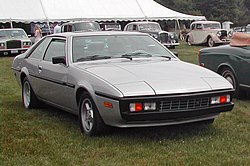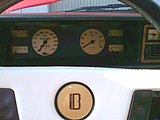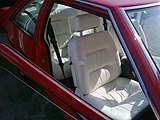Bitter SC
| Bitter | |
|---|---|
|
Bitter SC Coupé (1981–1989)
|
|
| SC | |
| Production period: | 1981-1989 |
| Class : | Sports car |
| Body versions : | Coupé , cabriolet , sedan |
| Engines: |
Petrol engines : 3.0–3.9 liters (132–154 kW) |
| Length: | 4910-5060 mm |
| Width: | 1820 mm |
| Height: | 1350-1370 mm |
| Wheelbase : | 2683-2683 mm |
| Empty weight : | 1515-1635 kg |
| Previous model | Bitter CD |
| successor | ( Bitter Type 3 ) |
The Bitter SC was the second model from the German manufacturer Bitter . It replaced the Bitter CD and was also based on Opel high-volume technology. The official presentation of the Bitter SC Coupé took place in spring 1980 on the occasion of the Formula 1 Grand Prix in Monaco , where it was used as a safety car .
The SC was produced from the beginning of 1981 and was available in three body versions over the years. In addition to the coupé, the volume model in the series, a convertible was offered from spring 1983 and a four-door notchback sedan called the SC Sedan from late summer 1985 .
Up to the end of production in late autumn 1989, a total of 488 copies of the Bitter SC series had been produced. The indirect successor was to be the Type 3 prototype.
Development history
The concept
At the SC, Erich Bitter repeated the conceptual approach of the CD. Again he created an elegantly designed vehicle with an Italian-style body and unproblematic large-scale production technology. Erich Bitter explained his preference for high-volume technology with the following words: “I want my car to start without problems even after five days in the cold when I park it in the mountains and go skiing. What is the point of a car that does not drive in difficult conditions? ”.
In the case of the SC, recourse to the sovereignly motorized Diplomat technology was ruled out: Opel had stopped production of the great Diplomat in the summer of 1977. It is true that Bitter still had a number of Diplomat parts, thanks to which the continuation of production of the CD was assured for another year; after that, however, the introduction of a new bitter model was inevitable. As early as the spring of 1977, Bitter was able to secure the right to use the Opel Senator A , which had not been presented at the time, as the technical basis for a new coupé. The advantage of this technology was its reliability and easy availability.
In terms of sportiness and exclusivity, however, it lagged well behind the eight-cylinder Diplomat. Some observers found the technology to be downright bourgeois and saw in it an essential reason for the low prevalence of the SC.
In contrast to the CD, Bitter received - apart from the provision of the technical components - no significant support from Opel. Bitter therefore had to carry out the development work alone; it lasted two years and cost around 8 million German marks . Bitter could only achieve this through external investments, namely through a Swiss industrialist.
body
As in the case of the CD, Erich Bitter initially only thought of a coupé variant. The first design of the body came from Erich Bitter himself. Unlike the CD, the new SC did not have a hatchback, but a notchback with a pronounced trapezoidal line that was clearly reminiscent of the Ferrari 400 designed by Pininfarina and a similar elegance in appearance and detail exhibited. Like this one, the Bitter SC also had pop-up headlights. Bitter's design was then revised by Opel designers Henry Haga and Georges Gallion. The detailed work on the design and the body structure was finally carried out by Giovanni Michelotti in Turin. All in all, the new car used many Opel parts, which, however, were not easily recognizable from the exterior. Add-on parts such as lights and door handles came from large-scale manufacturers, the rear lights, for example, were taken from the Lancia Beta Montecarlo (and not, as many suspected, from the Fiat X1 / 9 ), the front light units from the Ferrari Mondial .
The drive technology
In the early development phase there were plans to equip the SC with an eight-cylinder engine, just like the CD before. As drive sources, engines from Lamborghini - here the 3.5-liter eight-cylinder from the Urraco - and from Holden were considered and at least tested on test benches. However, this idea failed due to the noise and exhaust gas behavior of the large engines. Instead, Bitter made extensive use of the drive technology of the Opel Senator and the Opel Monza . The car was initially equipped with a six-cylinder in- line engine with a displacement of 2968 cm³ from the Senator, which had not been significantly changed . In the last model years it was also equipped with a 3848 cm³ in-line six-cylinder from tuner Mantzel. Individual vehicles were eventually given four-wheel drive from Ferguson.
The production
As with the Bitter CD, the production of the SC was largely outsourced. According to the concept common for small series manufacturers, the body was to be manufactured in an external factory before it was transported to Bitter in Schwelm and assembled there with the drive technology. The body of the CD was manufactured by Baur .
However, this path was ruled out for the SC. After the last CD left the Baur production line at the end of 1979, Baur found an alternative with the production of the BMW M1 that utilized the company to such an extent that there was no more capacity to build the new Bitter. Erich Bitter therefore moved to northern Italy, where there had been a large number of small, independent bodyworks for decades that produced bodies for other vehicle manufacturers either by hand or in small series. Initially, the choice fell on Carrozzeria OCRA in Turin , a comparatively young company with little experience. Between the beginning of 1981 and the spring of 1982, OCRA produced a total of 79 bodies, all of which were of poor quality. Given the use of Soviet recycled sheet metal, the cars were extremely susceptible to rust; some vehicles began to rust just a few months after delivery.
In the spring of 1982, Bitter terminated the contract with OCRA . Production was then relocated to Carrozzeria Maggiora , also based in Turin , an experienced and renowned company that at the time also produced bodies for Maserati and Bristol . Individual vehicles are also said to have been completed at Zagato . The leather for the interior was obtained from SALT in Turin . By the end of 1983 the vehicles were completed at Bitter in Schwelm. However, the small plant soon reached its limits, because usually only one car could be completed there per week.
In view of the plans for an expansion of production, Bitter finally found the opportunity to have the cars completed by Steyr Daimler Puch in Graz . Up until the end of 1989, around three to four cars were produced there every week.
Body versions
Coupe
The SC Coupé came onto the market in spring 1981 as the first version and thus represented the volume model of the series. With 461 copies produced, it was also the most common variant.
Cabriolet
In the spring of 1983, the series was supplemented by the SC Cabriolet. The top was based on a construction that the supplier Keinath had developed for a limited series of 144 convertibles based on the Opel Monza.
Only 22 convertibles were built by the end of 1989.
Sedan
The sedan was added to the model range from late summer 1985. It was a four-door notchback sedan designed primarily for sale in the United States . The vehicle was based on an extended chassis.
The first prototype was built in 1984. The SC Sedan was an extended version of the coupé. Drive technology and roof height remained unchanged. The prototype was powered by the 3.0 liter six-cylinder from the Opel Senator and had a manual five-speed gearbox. The series vehicles, which were manufactured from mid-1985, differed in some details from this prototype. All production vehicles had a higher roof. They were powered by the 3.9 liter Mantzel engine and all had an automatic transmission.
Only four series vehicles of the SC Sedan were produced until mid-1988. Three of them still exist; they are in the USA. The prototype now belongs to a Dutch collector.
Production figures and technical data
The motors
| model | power | Torque | compression | Bore × stroke |
|---|---|---|---|---|
| Bitter SC 3.0 | 132 kW (180 PS) at 5800 rpm | 248 Nm at 4800 rpm | 9.4: 1 | 95.0 mm × 69.8 mm |
| Bitter SC 3.9 | 154 kW (210 hp) at 5100 rpm | 327 Nm at 3400 rpm | 9.4: 1 | 95.0 mm × 90.5 mm |
Quantities
| model | Left hand drive | Right hand drive | Prototypes | total |
|---|---|---|---|---|
| Bitter SC Coupe | 432 pieces | 29 pieces | not known | 461 pieces |
| Bitter SC convertible | 20 piece | 1 piece | 1 piece | 22 pieces |
| Bitter SC Sedan | 4 pieces | 0 pieces | 1 piece | 5 pieces |
- Data
| model | length | width | height | wheelbase | Empty weight |
|---|---|---|---|---|---|
| Bitter SC Coupe | 4850 mm 4910 mm (US version) |
1820 mm | 1350 mm | 2683 mm | 1515 kg 1535 kg (autom.) 1540 kg (3.9) 1560 kg (3.9 autom.) |
| Bitter SC convertible | 4910 mm | 1820 mm | 1330 mm | 2683 mm | 1650 kg 1670 kg (autom.) |
| Bitter SC Sedan | 5060 mm | 1820 mm | 1370 mm | 2833 mm | 1590 kg 1610 kg (autom.) 1615 kg (3.9) 1635 kg (3.9 autom.) |
Performance
| model | Top speed | Acceleration from 0 to 100 km / h |
|---|---|---|
| Bitter SC 3.0 Coupé | 215 km / h 210 km / h (automatic) |
8.6 seconds 9.6 seconds (automatic) |
| Bitter SC 3.9 Coupé | 230 km / h 220 km / h (automatic) |
7.6 seconds 8.6 seconds (automatic) |
| Bitter SC 3.9 convertible | 215 km / h 210 km / h (automatic) |
7.8 seconds 8.8 seconds (automatic) |
| Bitter SC 3.0 Sedan | 215 km / h 210 km / h (automatic) |
8.8 seconds 9.8 seconds (automatic) |
| Bitter SC 3.9 Sedan | 230 km / h 220 km / h (automatic) |
7.8 seconds 8.8 seconds (automatic) |
Prominent bitter drivers
Both Bitter CD and Bitter SC were popular vehicles with celebrities. The best known bitter drivers that can be documented included:
- Paul Breitner
- Udo Lattek
- Rosi Mittermaier
- Christian Neureuther
- Bernhard Russi
- Ireen Sheer
- Dietrich Thurau
- Bernd Hölzenbein
- Jürgen Grabowski
- Uschi Glas
- Karl-Heinz Rummenigge
- Erich Ribbeck
- Howard Carpendale
- Heino
- Rainier III.
- Consul Weyer
- Walter Röhrl
- Anneliese Abarth
- Günter Netzer
- Heidi Hetzer
- Wolfgang Junginger
- Alfred Hagn
- Michael Nader
- Leopold Prince of Bavaria
- Terry Wogan
literature
- David Lillywhite, Halwart Schrader: Encyclopedia of Classic Automobiles . Motorbuch-Verlag, Stuttgart 2005, ISBN 3-613-02552-3 .
- Money no object: Aston Martin Lagonda vs. Bitter CD vs. De Tomaso Deauville vs. Iso Fidia vs. Maserati Quattroporte . Comparative test of Italian four-door cars in Thoroughbred & Classic Cars issue 9/2008, p. 60 ff.
Web links
- Website of the Bitter Club International
- Sales brochure from Bitter Italia for the SC Coupé with technical data
- Sales brochure from 1985 with images of the convertible and the sedan
Individual evidence
- ↑ Quoted from Thoroughbred & Classic Cars 9/2008. P. 62
- ↑ Lillywhite / Schrader, Encyclopedia of Classic Cars, p. 78
- ↑ Information on the Bitter SC on the website www.senatorman.de ( page no longer available , search in web archives ) Info: The link was automatically marked as defective. Please check the link according to the instructions and then remove this notice.
- ↑ www.senatorman.de ( page no longer available , search in web archives ) Info: The link was automatically marked as defective. Please check the link according to the instructions and then remove this notice.
- ↑ Lillywhite / Schrader, Encyclopedia of Classic Cars, p. 78
- ↑ Thoroughbred & Classic Cars 9/2008. P. 62
- ^ Paul Griffith: Bitter - The Cars, ISBN 0-9520944-0-1 , 1993, published by Bitter Owners Club
- ↑ Göbel, Kaiss: Erich Bitter - "just write your name on it!" Rennsport, Automobiles, Leben, 2013, ISBN 978-3-86884-161-9 , published by Sportverlag Strauss
- ^ A b Paul Griffith: Bitter - The Cars, ISBN 0-9520944-0-1 , 1993, published by Bitter Owners Club, p. 26








